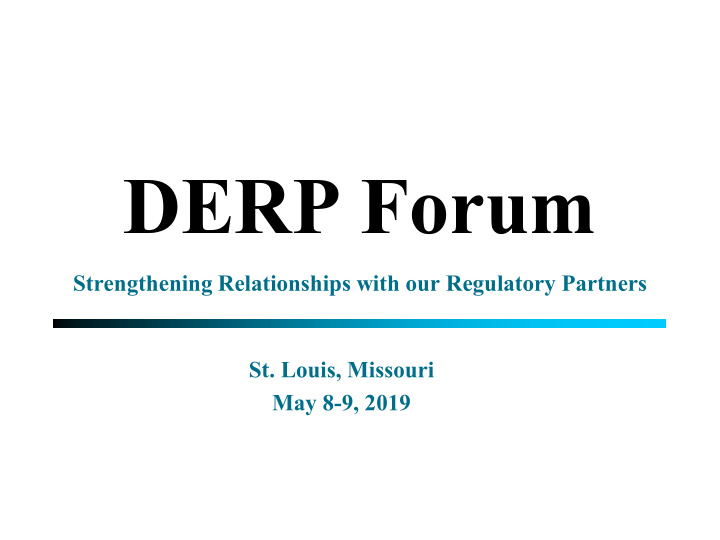



DERP Forum Strengthening Relationships with our Regulatory Partners St. Louis, Missouri May 8-9, 2019
Department of Defense Military Munitions Response Program DERP Forum May 9, 2019
MMRP • Military Munitions Response Program (MMRP) • MMRP Challenges • MMRP Tools • Partnering with Stakeholders
MMRP • DoD developed the MMRP inventory in 2001 (10 USC 2710) • Addresses hazards from unexploded ordnance (UXO), discarded military munitions (DMM), MRSs as of FY 2018 or munitions constituents (MC) Number of MRSs at – Does not include operational ranges, Response Total MRS operating storage or manufacturing facilities, Complete Inventory or permitted facilities for the treatment or (RC) Through disposal of military munitions FY 2018 • Published the Munitions Response Site Prioritization Protocol (MRSPP) (32 CFR 179) Active Installations 2,832 2,130 in 2005 which assigns munitions response sites (MRSs) a relative priority based on potential risk to human health and the environment BRAC Locations 360 273 – MRSs with a higher relative risk will usually be assessed first (“worst first”) – Other factors (e.g., community interests) can influence sequencing decisions
MMRP Challenges EPA • Inefficient use of time and resources digging harmless debris mistaken for munitions • Limited technology available to reduce costs and accelerate cleanup • Limited data to enhance regulator confidence in cleanup decisions and minimize the potential for residual risk • Lack of communication and coordination on project scoping, data quality objectives, and conceptual site module • Acute hazard creates a unique States DoD situation for determining future land use restrictions • No promulgated regulatory standards or “safe” levels • Variety of sites and munitions • Regulator oversight challenges
MMRP Tools • Advanced Classification for MRSs – Most reliable method of data analysis and classification for detecting subsurface objects that could be munitions; used during the remedial investigation/feasibility study cleanup phases • DoD Advanced Geophysical Classification Accreditation Program (DAGCAP) – Uses two third-party accreditation bodies to demonstrate competency and document conformance to DAGCAP requirements; 12 contracting organizations are DAGCAP accredited • MMRP Risk Management Method (RMM) – Uses data to support remedial action objectives (RAOs) and data quality objectives (DQOs) • Quality Assurance Project Plans (QAPPs): Advanced Geophysical Classification and Munitions Response – Facilitates up front planning; improves communication with regulators; builds confidence in tools; supports data quality, decision making, and regulatory buy-in
Partnering with Stakeholders • Partnering with stakeholders and maximizing transparency, public participation, and collaboration is vital to ensure cost effective and efficient decisions about the MMRP • Exchanging views and information, and working closely with federal and state regulators and other stakeholders to develop and refine the MMRP Tools – Munitions Response Dialogue (MRD) – Environmental Council of States (ECOS) – Interstate Technology & Regulatory Council (ITRC) – Association of State and Territorial Solid Waste Management Officials (ASTSWMO) – Environmental Data Quality Workgroup and Intergovernmental Data Quality Task Force (EDQW & IDQTF) – National Association of Ordnance Contractors (NAOC)
Recommend
More recommend